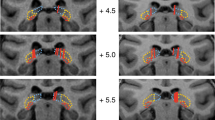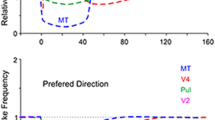Summary
We studied the influences of eye movements on the visual responses of neurons in two retinotopically organized areas of the pulvinar of the macaque. Cells were recorded from awake, trained monkeys, and visual responses were characterized immediately before and after the animals made saccadic eye movements. A significant proportion of the cells were more responsive to stimuli around the time of eye movements than they were at other intervals. Other cells had response reduction. For some neurons, the change in excitability was associated with orbital position and not the eye movement. For other cells the change was present with eye movements of similar amplitude and direction but with different starting and ending positions. Here it appears that the eye movement is the important parameter. Other cells had effects related to both eye position and eye movements. In all cells tested, the changes in excitability were present when the experiments were conducted in the dark as well as in the light. This suggests that the mechanism of the effect is related to the eye position or eye movement and not visual-visual interactions. For about half of the neurons with modulations, the response showed facilitation for stimuli presented in the most responsive region of the receptive field but not for those at the edge of the field. For the other cells there was facilitation throughout the field. Thus, a gradient of modulation in the receptive field may vary among cells. These experiments demonstrate modulations of visual responses in the pulvinar by eye movements. Such effects may be part of the visual-behavioral improvements at the end of eye movements and/or contribute to spatial constancy.
Similar content being viewed by others
References
Abrahams VC, Rose PK (1975) Projections of extraocular, neck muscle, and retinal afferents to the superior colliculus in the cat: their connections to the cells of origin of the tectospinal tract. J Neurophysiol 38:10–18
Acuña C, Gonzales F, Dominguez R (1983) Sensorimotor unit activity related to intention in the pulvinar of behaving Cebus apella monkeys. Exp Brain Res 52:411–422
Andersen RA, Mountcastle VB (1983) The influence of the angle of gaze upon the excitability of the light-sensitive neurons of the posterior parietal cortex. J Neurosci 3:532–548
Andersen RA, Essick GK, Siegel RM (1985) Encoding of spatial location by posterior parietal neurons. Science 230:456–458
Ashton JA, Boddy A, Donaldson IML (1984) Directional selectivity in the responses of units in cat primary visual cortex to passive eye movement. Neuroscience 13:653–662
Bartlett JR, Doty RW (1974) Influence of mesencephalic stimulation on unit activity in striate cortex of squirrel monkeys. J Neurophysiol 37:642–652
Bartlett JR, Doty RW, Lee BB, Sakakura H (1976) Influence of saccadic eye movements on geniculostriate excitability in normal monkeys. Exp Brain Res 25:487–509
Becker W (1976) Do correction saccades depend exclusively on retinal feedback? A note on the possible role of non-retinal feedback. Vision Res 16:425–427
Bender DB (1981) Retinotopic organization of the macaque pulvinar. J Neurophysiol 46:672–693
Bender DB (1982) Receptive field properties of neurons in the macaque inferior pulvinar. J Neurophysiol 48:1–17
Benevento LA, Fallon JH (1975) The ascending projections of the superior colliculus in the rhesus monkey (Macaca mulatta). J Comp Neurol 160:339–362
Benevento LA, Rezak M (1976) The cortical projections of the inferior pulvinar and adjacent lateral pulvinar in the rhesus monkey (Macaca mulatta): an autoradiographic study. Brain Res 108:1–24
Bizzi E (1968) Discharge of frontal eye field neurons during saccadic and following eye movements in unanesthetized monkeys. Exp Brain Res 6:69–80
Büttner U, Fuchs AF (1973) Influence of saccadic eye movements on unit activity in simian lateral geniculate and pregeniculate nuclei. J Neurophysiol 36:127–141
Campos-Ortega JA, Hayhow WR (1972) On the organization of the visual cortical projection to the pulvinar in Macaca mulatta. Brain Behav Evol 6:394–421
Cohen B, Feldman M, Diamond SP (1969) Effects of eye movement, brain-stem stimulation, and alertness on transmission through lateral geniculate body of monkey. J Neurophysiol 32:583–594
Crist CF, Yamasaki DSG, Komatsu H, Wurtz RH (1988) A grid system and a microsyringe for single cell recording. J Neurosci Methods 26:117–122
Deubel H, Wolf W, Hauske G (1982) Corrective saccades: effect of shifting the saccade goal. Vision Res 22:353–364
Deubel H, Wolf W, Hauske G (1984) The evaluation of the oculomotor error signal. In: Gale AG, Johnson F (eds) Theoretical 245 and applied aspects of eye movement research. Elsevier, North-Holland, pp 55–62
Donaldson IML, Dixon RA (1980) Excitation of units in the lateral geniculate and contiguous nuclei of the cat by stretch of extrinsic ocular muscles. Exp Brain Res 38:245–255
Donaldson IML, Long AC (1980) Interactions between orbital proprioceptive and visual signals in the superior colliculus of the cat. J Physiol (London) 298:85–110
Doty RW, Wilson PD, Bartlett JR, Pecci-Saavedra J (1973) Mesencephalic control of lateral geniculate nucleus in primates. I. Electrophysiology. Exp Brain Res 18:189–203
Foote WE, Mordes JP, Colby CL, Harrison TA (1977) Differential effect of midbrain stimulation on X-sustained and Y-transient neurons in the lateral geniculate nucleus of the cat. Brain Res 127:153–158
Galletti C, Battaglini PP (1989) Gaze-dependent visual neurons in area V3A of monkey prestriate cortex. J Neurosci 9:1112–1125
Gattass R, Oswaldo-Cruz E, Sousa APB (1979) Visual receptive fields of units in the pulvinar of cebus monkey. Brain Res 160:413–430
Goldberg ME, Robinson DL (1980) The significance of enhanced visual responses in posterior parietal cortex. Behav Brain Sci 3:503–505
Goldberg ME, Wurtz RH (1972) Activity of superior colliculus in behaving monkey. I. Visual receptive fields of single neurons. J Neurophysiol 35:542–559
Graham J (1982) Some topographical connections of the striate cortex with subcortical structures in Macaca fascicularis. Exp Brain Res 47:1–14
Harting JK, Huerta MF, Frankfurter AJ, Strominger NL, Royce GJ (1980) Ascending pathways from the monkey superior colliculus: an autoradiographic analysis. J Comp Neurol 192:853–882
Kennedy H, Bullier J (1985) A double-labeling investigation of the afferent connectivity to cortical areas V1 and V2 of the macaque monkey. J Neurosci 5:2815–2830
MacKay DM (1973) Visual stability and voluntary eye movements. In: Jung R (ed) Handbook of sensory physiology, Vol 7, Part 3 A. Central processing of visual information. Springer, Berlin, pp 307–331
McIlwain JT (1964) Receptive fields of optic tract axons and lateral geniculate cells: peripheral extent and barbiturate sensitivity. J Neurophysiol 27:1154–1173
Munson JB, Graham RB (1971) Lateral geniculate spikes in sleeping, awake, and reserpine-treated cats: correlated excitability changes in superior colliculus and related structures. Exp Neurol 31:326–336
Ogren MP, Hendrickson AE (1976) Pathways between striate cortex and subcortical regions in Macaca mulatta and Saimiri sciureus: evidence for reciprocal pulvinar connections. Exp Neurol 53:780–800
Ogren MP, Hendrickson AE (1977) The distribution of pulvinar terminals in visual areas 17 and 18 of the monkey. Brain Res 137:343–350
Partlow GD, Colonnier M, Szabo J (1977) Thalamic projections of the superior colliculus in the rhesus monkey, Macaca mulatta: a light and electron microscopic study. J Comp Neurol 171:285–318
Perryman KM, Lindsley DF, Lindsley DB (1980) Pulvinar neuron responses to spontaneous and trained eye movements and to light flashes in squirrel monkeys. Electroencephalogr Clin Neurophysiol 49:152–151
Petersen SE, Robinson DL, Keys W (1985) Pulvinar nuclei of the behaving rhesus monkey: visual responses and their modulations. J Neurophysiol 54:867–886
Raczkowski D, Diamond IT (1978) Cells of origin of several efferent pathways from the superior colliculus in Galago senegalensis. Brain Res 146:351–357
Richmond BJ, Optican LM, Podell M, Spitzer H (1987) Temporal encoding of two-dimensional patterns by single units in primate inferior temporal cortex. I. Response characteristics. J Neurophysiol 57:132–146
Rizzolatti G, Camarda R, Grupp LA, Pisa M (1974) Inhibitory effect of remote visual stimuli on visual response of cat superior colliculus: spatial and temporal factors. J Neurophysiol 37:1262–1275
Robinson DL, Goldberg ME, Stanton GB (1978) Parietal association cortex in the primate: sensory mechanisms and behavioral modulations. J Neurophysiol 41:910–932
Robinson DL, Kertzman C, McClurkin JW (1987) The macaque pulvinar: increases in visual sensitivity following saccadic eye movements. Soc Neurosci Abstr 13:862
Robinson DL, McClurkin JW (1989) The visual superior colliculus and pulvinar. In: Wurtz RH, Goldberg ME (eds) The neurobiology of saccadic eye movements. Rev Oculomotor Res 3:337–360
Robinson DL, Petersen SE (1985) Response of pulvinar neurons to real and self-induced stimulus movement. Brain Res 338:392–394
Robinson DL, Petersen SE, Keys W (1986) Saccade-related activity in the pulvinar nuclei of the behaving rhesus monkey. Exp Brain Res 62:625–634
Robinson DL, Wurtz RH (1976) Use of an extraretinal signal by monkey superior colliculus neurons to distinguish real from self-induced stimulus movements. J Neurophysiol 39:852–870
Sakata H, Shibutani H, Kawanno K (1980) Spatial properties of visual fixation neurons in posterior parietal association cortex of the monkey. J Neurophysiol 43:1654–1672
Sakata H, Shibutani H, Kawano K, Harrington TL (1985) Neural mechanisms of space vision in the parietal association cortex of the monkey. Vision Res 25:453–463
Schlag J, Schlag-Rey M, Peck CK, Joseph JP (1980) Visual responses of thalamic neurons depending on the direction of gaze and the position of targets in space. Exp Brain Res 40:170–184
Singer W (1977) Control of thalamic transmission by corticofugal and ascending reticular pathways in the visual system. Physiol Rev 57:386–420
Singer W, Bedworth N (1974) Correlation between the effects of brain stem stimulation and saccadic eye movements on transmission in the cat lateral geniculate nucleus. Brain Res 72:185–202
Singer W, Dräger U (1972) Postsynaptic potentials in relay neurons of cat lateral geniculate nucleus after stimulation of the mesencephalic reticular formation. Brain Res 41:214–220
Suzuki H, Taira N (1961) Effect of reticular stimulation upon synaptic transmission in cat's lateral geniculate body. J Physiol 11:641–655
Trojanowski JQ, Jacobson S (1976) Areal and laminar distribution of some pulvinar cortical efferents in rhesus monkey. J Comp Neurol 169:371–392
Trojanowski JQ, Jacobson SJ (1977) The morphology and laminar distribution of cortico-pulvinar neurons in the rhesus monkey. Exp Brain Res 28:51–62
Ungerleider LG, Galkin TW, Mishkin M (1983) Visuotopic organization of projections from striate cortex to inferior and lateral pulvinar in rhesus monkey. J Comp Neurol 217:137–157
Wilson JS, Goldberg SJ (1980) Inputs of the pulvinar and lateral posterior nucleus into the abducens nucleus of the cat. xp Neurol 68:72–86
Wolf W, Hauske G, Lupp U (1978) How presaccadic gratings modify postsaccadic modulation transfer function. Vision Res 18:1173–1179
Wolf W, Hauske G, Lupp U (1980) Interaction of pre- and postsaccadic patterns having the same coordinates in space. Vision Res 20:117–125
Wurtz RH, Mohler CW (1976) Organization of monkey superior colliculus: enhanced visual response of superficial layer cells. J Neurophysiol 39:745–765
Wurtz RH, Richmond BJ, Judge SJ (1980) Vision during saccadic eye movements. III. Visual interactions in monkey superior colliculus. Neurophysiol 43:1168–1181
Zipser D, Andersen RA (1988) A back-propogation programmed network that stimulates response properties of a subset of posterior parietal neurons. Nature 331:679–684
Author information
Authors and Affiliations
Rights and permissions
About this article
Cite this article
Robinson, D.L., McClurkin, J.W. & Kertzman, C. Orbital position and eye movement influences on visual responses in the pulvinar nuclei of the behaving macaque. Exp Brain Res 82, 235–246 (1990). https://doi.org/10.1007/BF00231243
Received:
Accepted:
Issue Date:
DOI: https://doi.org/10.1007/BF00231243




